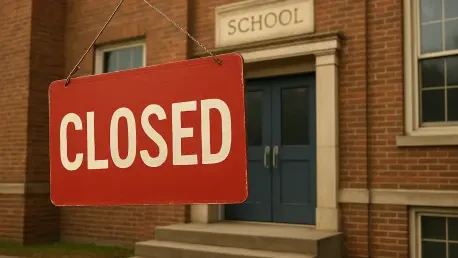In Florida, a mounting wave of anxiety over immigration enforcement near educational institutions is fundamentally altering the landscape of public schooling, as reports from collaborative journalism efforts highlight how the dread of Immigration and Customs Enforcement (ICE) actions drives a significant decline in student enrollment across the state. This issue touches not only the families directly affected but also the broader community, as schools—long considered safe havens—become zones of uncertainty. The personal stories of those uprooting their lives to escape potential detentions, combined with stark statistical evidence from major school districts, paint a troubling picture of the intersection between federal policy and local education. As this fear permeates immigrant communities, the ripple effects challenge the very foundation of accessible learning, raising urgent questions about how to protect vulnerable students and maintain trust in educational environments amidst such turbulent times.
Policy Changes Fueling Fear
The root of this crisis lies in significant policy shifts that have intensified fears among immigrant families in Florida. A notable rollback of protective measures under the Trump administration in January reversed earlier restrictions, initially set in 2011 and expanded under Biden, which limited ICE operations in sensitive areas like schools and churches. This change has created a pervasive sense of insecurity, as families now grapple with the possibility of agents conducting enforcement activities near school grounds. The anxiety is palpable, with many parents opting to keep their children at home rather than risk encounters during routine activities like drop-offs. This policy reversal has not only undone years of safeguards but also shifted the perception of schools from places of safety to potential danger zones, fundamentally altering how immigrant communities engage with public education systems in the state.
Further compounding this issue is the lack of clear boundaries around enforcement actions, which heightens the uncertainty for families already living on edge. Even though no confirmed ICE raids have been reported on school premises in Florida since the policy change, the mere threat looms large over daily decisions. Isolated incidents in other regions, such as agents appearing near schools in California, feed into a broader narrative of risk that transcends state lines. This perception, more than actual events, drives behavior, with parents weighing the potential consequences of sending their children to class against the backdrop of possible family separation. The psychological toll is immense, as the fear of deportation overshadows the pursuit of education, leaving many to question whether the benefits of schooling outweigh the dangers of visibility in such a charged environment.
Enrollment Drops Reflect Community Anxiety
Across Florida’s largest school districts, the impact of these fears manifests in staggering enrollment declines that far exceed expectations. In Orange County, student numbers dropped by approximately 6,600, more than double the anticipated loss to charter schools. Broward County reported a decline of over 11,300 students, while Miami-Dade County saw a reduction of more than 13,000, against a predicted drop of just 5,000. These sharp decreases are particularly pronounced in areas with significant immigrant populations, suggesting a direct correlation between the fear of immigration enforcement and school attendance. The numbers reveal a troubling trend where entire communities are opting out of public education, driven by the need to protect family members from potential detentions during what should be routine school days.
This disproportionate impact on Hispanic and non-white communities underscores deeper societal tensions surrounding immigration and belonging. As Stephanie Vanos, an education official in Orange County, has pointed out, a harmful narrative that “non-white people don’t belong here” exacerbates the alienation felt by many families. This sentiment, coupled with the ever-present threat of ICE actions, creates a chilling effect that extends beyond individual households to entire neighborhoods. Schools in these areas are seeing empty desks and diminished classroom diversity, which not only affects the students who leave but also alters the cultural fabric of the learning environment for those who remain. The loss of these students represents more than just numbers; it signifies a fracture in the community trust that schools rely upon to foster inclusive and supportive spaces for all learners.
Erosion of Safe Learning Spaces
Education leaders across Florida are increasingly vocal about the erosion of schools as sanctuaries for learning due to the looming threat of immigration enforcement. The potential presence of ICE agents near campuses adds a layer of anxiety to an environment already burdened by safety concerns such as active shooter drills and lockdowns. Debbi Hixon, a school board member in Broward County, has emphasized that schools should be places where students feel secure, not where they fear for their family’s stability. This shift in perception undermines the fundamental purpose of educational institutions, turning them into spaces of uncertainty rather than growth. The compounding of these fears creates a hostile atmosphere that distracts from academic focus and challenges educators’ ability to provide a nurturing environment for their students.
Beyond the immediate emotional impact, there are significant long-term risks for students who are pulled from the public school system due to these fears. Many education officials, including Vanos, express deep concern that children who leave may not be receiving any form of education at all. Additionally, incidents like the deportation of Wualner Sauceda, a teacher in Hialeah, demonstrate how enforcement actions—even when they occur outside school grounds—can ripple through entire communities, further eroding trust. Such events send a message that no one is immune, intensifying the climate of fear and instability. The loss of educators and students alike disrupts the continuity of learning and diminishes the sense of community that schools strive to build, leaving lasting scars on both academic outcomes and social cohesion in affected areas.
Barriers to Understanding and Solutions
One of the most significant challenges in addressing this crisis is the silence that pervades immigrant communities out of fear of repercussions. As Sarah Leonardi from Broward County has noted, many families are reluctant to speak publicly about their struggles, leaving educators and policymakers with largely anecdotal evidence to gauge the scope of the problem. This reticence complicates efforts to collect comprehensive data and develop targeted interventions, as the full extent of the enrollment decline tied to immigration fears remains unclear. Without voices from those directly impacted, the narrative risks being incomplete, hindering the ability of school districts to advocate effectively for protective measures or to tailor support services that could help retain students in the classroom despite the external pressures they face.
Compounding this issue is the difficulty in separating the effects of immigration enforcement fears from other factors contributing to enrollment declines, such as shifts to charter schools. While officials like Miami-Dade Superintendent Jose Dotres caution against attributing the drops solely to ICE-related anxieties, the consensus among many educators points to this fear as a primary driver, especially in immigrant-heavy districts. Addressing this multifaceted problem requires innovative approaches, including building stronger community outreach to reassure families of their safety and advocating for federal policies that restore schools as protected zones. Collaborative efforts between school boards, local governments, and advocacy groups could pave the way for creating environments where education remains accessible, ensuring that no child is forced to sacrifice learning due to the shadow of enforcement actions.
Pathways Forward for Florida’s Schools
Reflecting on the challenges faced, it becomes evident that the fear of immigration arrests has profoundly disrupted Florida’s educational landscape. The rollback of protective policies has instilled a pervasive dread among immigrant families, leading to unprecedented enrollment declines in districts like Orange, Broward, and Miami-Dade. Schools, once seen as bastions of safety, have been transformed into spaces of uncertainty, with the emotional and academic toll on students growing ever more apparent. Personal accounts, such as that of Alex Rodriguez Silva who moved his family to Denver, highlight the human cost of these policies, while educators grapple with the loss of trust within their communities.
Moving forward, actionable steps must be prioritized to rebuild confidence in public education systems. School districts should collaborate with local leaders to establish clear no-enforcement zones around campuses, sending a strong message of protection. Additionally, expanding counseling services to address the psychological impact on students and families could help mitigate fears. Advocacy for federal policy revisions to reinstate safeguards in sensitive areas remains crucial, ensuring that education is not sidelined by immigration enforcement concerns. By fostering dialogue and implementing supportive measures, there is an opportunity to restore schools as true sanctuaries of learning for every child, regardless of background.









